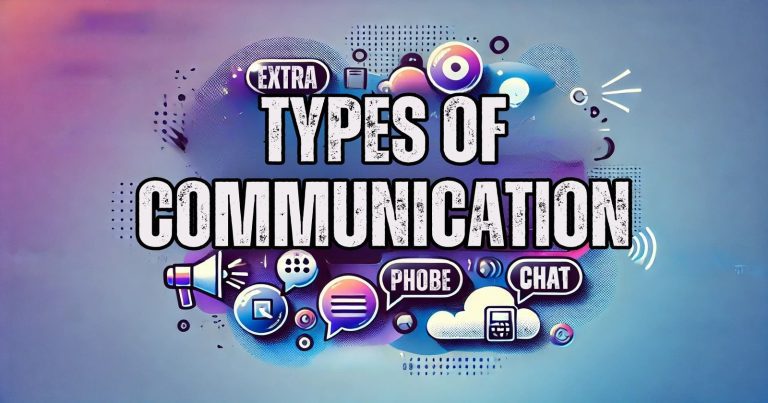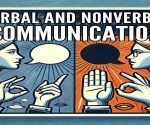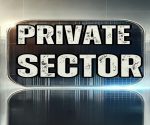Communication is the fundamental component of human relationships. Due to communication, people express their minds, share their thoughts, and relate their feelings. The character of communication presents the channel through which people send, receive, and decode messages under different conditions, which may be varied. Verbal communication types include those written or delivered through gestures and images. Communication can be applied to personal levels, workplaces, educational institutions, or media. This knowledge of types of communication allows people to work on their skills, remove all barriers to communication, and strengthen relationships. The article discusses different types of communication, their strengths, weaknesses, and real-life applications.
What are Communication Skills?
The ability to transfer information clearly and effectively, as well as to speak, listen, write, and interpret non-verbal signals, are included in communication skills. Effective communication, with confidence in the ability to deliver an idea, can make a person not only capable of listening and understanding other people but also build a way of connecting and developing friendships in professional settings, in leadership situations, or simply during conversations.
Good communication skills incorporate active listening, clear articulation, emotional intelligence, and adaptability. They help enhance teamwork, negotiation, and good decisions. However, barriers to communication between different types of communication will bring this to an end. Language barriers, cultural miscommunications, and disturbances fall within such factors. This can only be practised with patience over time by recognizing different types of communication and their working mechanism.
Types of Communication
Communications can be classified into a variety of types, including verbal and non-verbal, written and visual communication. Each type plays an important role in expressing messages effectively in various individual and professional settings.
1. Verbal communication
The verball communication refers to the use of oral words to express the message. This includes conversation, speech, calls and video meetings. Tone, pitch and volume are the major conveyors in giving an oral message. Communications are used in workplace, classrooms and individual encounters.
Immediate verbal and face-to-face communication can lead to direct interaction and instant responses, as it can also develop relationships through timely discussion. However, tone and pronunciation sometimes lead to misinterpretation. A clear voice, positive self-talk, and listening skills are essential to successful verbal communication.
Strengths
- Facilitates prompt feedback
- Enables personal connection
- Fosters teamwork and cooperation
- Aids persuasion and motivation
- Works well for quick discussions
- Requires active listening
Weakness
- It tends to be misinterpreted because of the tone or accent
- This can lead to conflict if it is not clear
- Short-lived; needs repetition for retention
- Cannot be documented for future reference
2. Non-verbal communication
Non-verbal communication does not use words; It communicates with the language of the body, facial expressions, gestures and voice tones. For example, a smile may indicate happiness, while a component may show discomfort. The gestures, such as shaking heads, compromises, and a person’s crossing weapon may indicate defensiveness. Green or nervous-veraging materials can be painted through asana and eye contact can be used to communicate a person’s caution and respect. In any spoken communication, the voice of the voice, whether sweet, excited, or adds meaning to the words, which is being expressed, clearly or transforms it.
Strengths
- Enhances verbal communication
- Helps express emotions effectively
- Can communicate when words fail
- Builds trust and credibility
- Requires observation and interpretation skills
- Works well in silent communication environments
Weaknesses
- It can be misinterpreted easily
- Different cultures may interpret gestures differently
- It cannot be used for complex information
- Lacks clarity without verbal support
3. Written Communication
Emails, letters, reports, books, and social media messages are some of the forms of written communication. It helps individuals document information and convey ideas to others from long distances. Businesses, legal institutions, and educational organizations predominantly use written communication.
This type of communication is transparent and precise. It enables people to refer to messages later, which minimizes the possibility of misunderstandings. However, written communication lacks an emotional tone and does not provide immediate feedback. Misinterpretation may take place if the message is not well-structured. Good writing skills are necessary for effective written communication.
Strengths
- Offers a permanent record
- Aids in clear and structured communication
- Suitable for legal and official documentation
- Requires good writing skills
- Enables long-distance communication
- Useful for complex instructions
Weaknesses
- Does not offer immediate feedback
- It may be misinterpreted if not well-written
- Lacks emotion transfer
- Often requires more time to write and to read
4. Oral Communication
Oral communication refers to the conversation between two or more persons whereby speeches, debates, discussions, and even telling are performed. This is an ideal tool for the immediate transfer of ideas; hence, it is widely applied in meetings of business firms, interviews, and public presentations.
The speaking people can maintain a discussion whereby each gives time to air opinions. Oral communication allows the fast making of decisions and incites participation. However, confusion, nervousness, or lousy pronunciation might diffuse oral communication. Tremendous oral communication requires confidence, clarity of articulation, and effective presentation.
Strengths
- It makes the listener fully attentive
- It necessitates one to be bold and clear
- Helps to win over the opposing party
- It allows an immediate interaction
- Helps in relationships
- Official discussions and brainstorming
Weakness
- One’s nervousness or shyness can limit it
- It is bounded by time and place
- Lacking documentation for subsequent reference
- Vulnerability to disturbance by background noise
5. Official Communication
Formal communication takes place formally or step by step. Formal communications are always resorted to while communicating professionally, verbally, or on academic platforms. Examples of formal communication are email, business meetings or reports, official declarations, and contracts.
Such communication is professional and transparent. It avoids all kinds of miscommunications that always kill credibility. Formal communication is stiff and devoid of personal warmth. Organizations formally communicate to the public to establish consistency and authority.
Strengths
- It ensures professionalism and respect
- It gives clear and documented information
- It helps in maintaining organizational discipline
- It reduces misunderstandings due to the precise wording
Weaknesses
- It enhances credibility and trust
- It can be slow due to bureaucratic processes
- It lacks flexibility for informal discussions
- It can be rigid and impersonal
- It requires approval and verification processes
- Will not permit timely decision-making
6. Informal Communication
Informal communication is highly informal; therefore, it occurs between friends, family members or individuals at work. Its use happens spontaneously and is not regulated or bound by established rules. Of course, one uses informal communication in informal person-to-person discussions, instant messaging, or friendly emails.
Informal is relationship building and will allow free expression, so it is a very effective kind of brainstorming and teamwork. Lack of documentation can lead to misinformation if one is not well guided. Balance informal and formal communications in any workplace.
Strengths
- Encourages open conversations
- Fosters strong relationships
- Helps in stress relief and teamwork
- Speeds up decision-making
- More interesting and participating
Weaknesses
- This may lead to gossip or misinformation
- Lacks proper documentation
- Not suitable for formal settings
- May create misunderstandings
- This may lead to unverified or unstructured information
Examples of Types of Communication
Examples of communication help illustrate how different types are used in daily life. They showcase real-world verbal, non-verbal, written, and visual communication scenarios in personal and professional interactions.
1. Verbal Communication
Verbal communication is a means of communicating through spoken or written words. Face-to-face conversation, for instance, is where people hold direct discussions. Another form is phone calls, which help convey messages over long distances. Then, there are meetings and presentations, which are other forms through which people can share ideas and information in a structured manner. Job interviews also use verbal communication since candidates express their views and answer the questions. On the other hand, video conferencing, such as Zoom or Google Meet calls, enables one to hold live discussions despite being miles apart.
2. Non-verbal Communication
Non-verbal communication does not use words; it communicates with body language, facial expressions, gestures, and tone of voice.
For instance, a smile may indicate happiness, while a frown may show discontent. Gestures, such as nodding, convey agreement, and an individual’s crossing arms might indicate defensiveness. Joyous or nerve-wracking content can be portrayed through posture and using eye contact to communicate a person’s attentiveness and respectfulness. In any spoken communication, the tone of voice, whether mellow, excited, or stern, adds meaning to words, clarifying or transforming the message that is being conveyed.
3. Written Communication
Written communication is the process of sending messages through written words, which ensures clarity and record-keeping.
Emails are a typical example of professional and personal exchanges.
Text messages allow quick and direct communication, while formal letters and business reports provide structured and detailed information. Social media posts also serve as a form of written communication, enabling individuals and organizations to share updates, ideas, and promotional content. Such communications help to record documents and are generally very effective means of communication over a large base.
4. Visual Communication
Visual communications use images, symbols, and graphic elements to portray information.
Infographics use visuals to depict heavy data in understandable formats.
Signs and symbols guide and warn in most cases. An example of them is the road traffic lights;
Videos are powerful; most media outlets use them widely in marketing, education, and even entertainment when conveying a particular message through visible images. Graphs and charts are commonly used in business and academics to represent statistical information, making data interpretation more straightforward. Using visuals, communication becomes more engaging and impactful.
Types of Communication FAQs
What are the four types of communication?
There are four principal types of communication: verbal, non-verbal, written, and visual. One type plays a crucial role in conveying information.
What are the types of barriers to communication?
Language, culture, technical, and psychological barriers to message clarity fall under this category.
What is the difference between formal and informal communication?
Formal communication follows a structured pattern in the professional world, whereas informal is informal and unstructured.
Why is written communication relevant?
It provides a permanent record of information in case of written communication, besides clarity. It is the origin of formal documentation.
What are mass communications?
Newspapers, television, social media sites, and news channels online are examples of mass communications.


